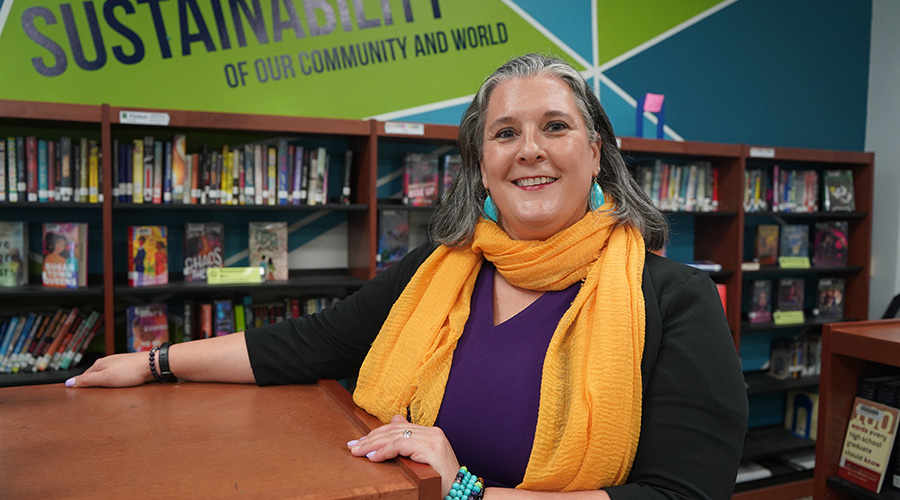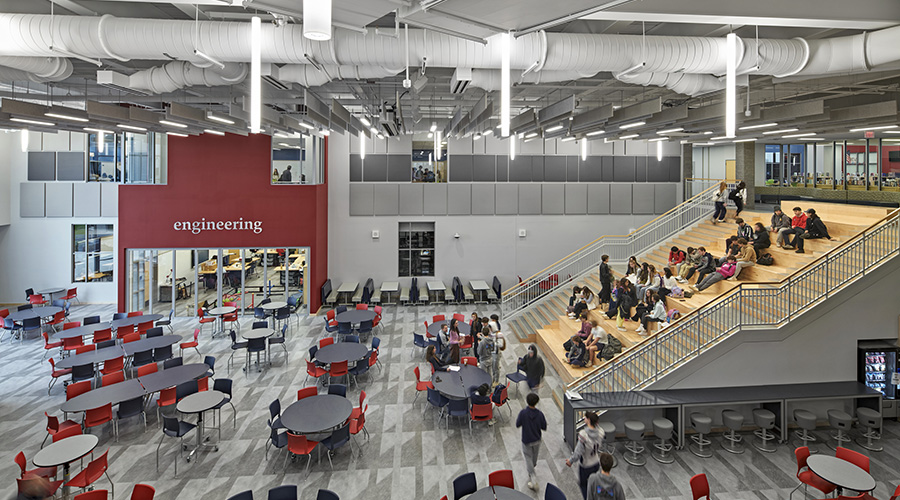 Photo courtesy of Boston Public Schools
Photo courtesy of Boston Public SchoolsBoston Public Schools Guided by Facility Condition Assessment
Teresa Neff-Webster, interim chief operating officer, helps lead school district past pandemic and into a brighter future
By Dave Lubach, Executive Editor
During a distinguished career in education that’s taken her from Chicago to London and now to Boston, Teresa Neff-Webster has carried one valuable trait through her travels.
“Having the initiative to want to learn and grow was actually going to be kind of my superpower,” she says.
As the daughter of a father who was a mechanical engineer and a mother who was an actress, Neff-Webster, the interim chief operating officer for Boston Public Schools, is a combination of her parents’ personalities.
Her analytical mind comes from her dad through such activities as color-coding work lists. From mom she inherited the necessary charisma to inspire her team and work with school officials and city leaders to sell what the district’s buildings need.
Neff-Webster's drive to succeed? That’s all hers.
“Teresa gets stuff done,” says sustainability, energy and environment program director for the district, Katherine Walsh, who opted for a more colorful noun in her quote. “She’s not leaving people off the bus. She’s making sure we’re all coming along with her, but she’s very talented at making sure things are getting done and people are being held accountable.”
Time for a change
Like so many leaders in facility management, Neff-Webster's working career started in a different profession.
She is in her fourth decade of a career in education, starting as a kindergarten teacher near her hometown of Chicago in 1993 before moving on to Chicago Public Schools in 1999 and eventually landing a kindergarten position at an international school in London from 2003 to 2006.
When she and her husband moved back to the United States, Neff-Webster decided it was time for a career shift.
“I just decided I was done with being in the classroom, and I needed to look outside the classroom,” she says. “I had been on a path to move into administrative roles, like a vice-principal or dean.”
She took a role as the director of school operations in 2009 at a charter school where she oversaw a $4 million budget and handled most everything at the school outside the classroom realm.
“In that role I learned managing transportation, enrollment, safety, food service, facilities, health, all of it,” she says. “All in one fell swoop. It was really a training ground for me; that kind of understanding on a field level, all the inner workings of facilities in particular, and all those other critical operational areas.”
She eventually rose to the level of senior director of operational learning and development, helping to open a school in Providence, Rhode Island, and handling operations at seven other schools in the region.
“That was a whole other brand-new facilities world, finding a partnership with our facilities team,” Neff-Webster says of leading the creation of a new school. “So, I've kind of had the opportunity to learn on the job.”
A two-year stint at another school organization as chief operating officer, where she designed, implemented and managed internal systems as part of her role, set the stage for her current home – Boston Public Schools, where all her on-the-job training was immediately put to the test.
Early challenges
Neff-Webster took over as the deputy chief operating officer at Boston Public Schools in March 2020, responsible for overseeing a $250 million budget and handling operations that included facilities, technology and transportation, among other departments.
She was all set to hit the ground running when, like the rest of the country, the district was blindsided by the COVID-19 pandemic.
“Literally, the day that we shut down for COVID,” was her first day on the job, Neff-Webster says.
The pandemic put all her plans on hold.
“Everyone was in the exact same situation,” she recalls. “I had several conversations with colleagues in the New York public schools and they were in the exact same spot that I was, even though they’d been in facilities roles for decades. We were all learning literally week to week what we needed to be looking at, what we needed to be investigating, how we needed to be creating spaces that could bring our students back, and then also problem solving — not only in the moment what we needed to do, but to also make mid- and long-term plans for our buildings.”
It wasn’t until the 2021-2022 school year when the district’s students and faculty came back to in-person classes full-time. But as the pandemic ran its course, Neff-Webster's team was in the process of preparing the district’s buildings for a better future.
Her first major project beyond the pandemic preparations was to conduct a facility condition assessment – an ambitious task considering the district has 130 buildings of which 120 are school buildings housing 54,000 students – made worse when she took the initial step to start.
“I asked my then-CEO to see the building list, and nothing existed,” she says. The district had no documents that tracked its own assets in its buildings. The development left her stunned.
“I was surprised, and we can leave it at that,” she says. “But I took that as a challenge.”
The district hired a third party to help conduct the assessment, which took 18 months but gathered “hundreds of thousands of data points. It sounds simple, but it’s actually quite a large project if you’ve never done it before,” she says of the assessment.
Road to recovery
Each building received two reports – one that outlined asset quality and another that focused on Americans with Disabilities Act accessible spaces.
“Some of the reports are numbered in the hundreds of pages and some are like 20-some odd pages,” Neff-Webster says. “Any member of our community can go directly to their school and see the score their building has.”
The assessment revealed the long road that the district would need to travel to get its buildings on track. As the oldest school district in the country, many of Boston Public Schools’ buildings date back to before World War II. Two-thirds of the buildings lacked HVAC systems, which led to 85 buildings receiving window air conditioning units and another five buildings entering a pilot program to determine how to retrofit HVAC systems into their sites. The assessment helped the district learn the age of the actual HVAC assets it did have. The district also learned that the “newer” buildings from the 1970s were failing more rapidly than the older buildings.
The general takeaway from the assessment was “we have very low scoring buildings, which is something that we’re working to address,” Neff-Webster says.
Responding to the assessment, she helped implement a 10-year infrastructure plan to address the problems. In response to the pandemic and the need to improve indoor air quality (IAQ) in the schools, the district launched an IAQ project, supported through ESSER funds. The district’s efforts have earned national recognition from the U.S. Department of Education and other such acknowledgements from the U.S. Green Building Council.
Brian Forde is the facilities department’s executive director who joined the school district during the pandemic in 2021. Working alongside Neff-Webster during that time, he gives a lot of credit for the district’s revival to her ability to get things done.
“Operations is definitely kind of under the radar where things happen and we don’t really get the attention,” Forde says. “I think one thing that most people don’t see are the organizational skills that Teresa brings to the table, probably because most people don’t go to her office because she’s coming to yours, which is another great aspect of her.”
During discussions about the failing condition of the school buildings, Neff-Webster learned that she had city and district leaders in her corner.
“It’s not a secret that Boston Public Schools facilities have been disinvested in for a very long time,” she says. “We were fortunate enough that our city leadership and district leadership, both then and now, took the opportunity of the pandemic to really say to myself and the facilities department, ‘What do we need to bring both our students back and then also invest in our buildings?’.”
While hopeful for the future, Neff-Webster stays realistic that the upgrades will not happen overnight.
“I don’t believe we’re going to be able to fix everything in five or 10 years,” she says. “I do believe we’re going to make incremental progress toward that goal. It’s important for us to think about that as we react to on-fire items daily. We need to just keep that incremental strategic work moving forward.”
The assessment remains one of Neff-Webster's proudest career moments.
“I’m exceptionally proud that the city of Boston now has a way to assess what’s going on in our buildings,” she says. “Now it’s translated to the rest of the city departments that want to do facility condition assessments for their buildings. In the state of Massachusetts, we are one of the few school districts in the state to have done this correctly.”
Industry leader
As a woman in a male-dominated industry, Neff-Webster, who was promoted to her current position as interim chief operating officer in June 2023, has felt the scrutiny of others questioning her presence when she is often the only woman in a meeting.
“It’s less now, but there’s always a sense of (others wondering), ‘Oh, isn’t she cute? Or ‘I wonder why she’s here?’ And then there’s the, ‘Let me mansplain facilities to you,” she says. “It’s still interesting to me to walk into a room where it’s so heavily populated with men and navigating that is complex.”
Walsh is one of those women who often shares a meeting room with Neff-Webster.
“Just having a strong female leader in operations is really important and inspiring,” she says. “That’s not always the case.”
While Neff-Webster has distinguished herself among her peers, it’s clear that she values her responsibility as a role model for other women seeking careers in facilities management.
“As a woman, and frankly as a former teacher, the different perspective I bring to the table is often appreciated because it is so different from the very clinical background,” she says. “Here in Boston, I work with a lot of very strong women who were in mid-managerial positions in facilities and operations, and they see my role as an acceptable path that they can get to. When I was coming up, it was very much not like that. I’m excited to be part of that, like a mentorship of women who are coming up in this industry and changing the conversation from ‘there’s a woman on the panel’ to ‘there's a panel and there happens to be some women on it.’”
Dave Lubach is the executive editor for the facilities market. He has nine years of experience writing about facility management and maintenance issues.
Related Topics:












